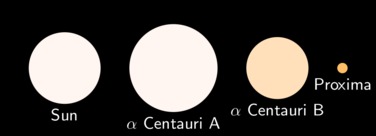Alpha Centauri (or Rigel Kentaurus, as it is also known) is actually a system of three stars gravitationally bound together. The two main stars are Alpha Centauri A and Alpha Centauri B. The tiniest star in the system is Alpha Centauri C, a red dwarf.
The Alpha Centauri system is a special one. At an average distance from us of 4.3 light-years, these stars are our nearest known stellar neighbors.
Centauri A and B are remarkably Sun-like, with Centauri A a near twin of the Sun (both are yellow G stars). In comparison to the Sun, Alpha Centauri A is 1.5 times as luminous and shines at magnitude -0.01 while Alpha Centauri B is half as luminous and shines at magnitude 1.3.
Alpha Centauri C is one seven-thousandth as bright and shines at eleventh magnitude.
Of the three stars, the smallest is the closest to the Sun, 4.22 light-years away. Because of its proximity, it is known as Proxima Centauri.
When night falls and the skies are clear in summer, the Alpha Centauri system shines at a magnitude of minus-0.27, low in the southern sky. You can find it at the foot of the Centaur in the constellation Centaurus.
Because of its position in the sky, the Alpha Centauri system is not easily visible in much of the northern hemisphere. An observer must be at latitudes south of 28 degrees north (or roughly from Naples, Florida and locations further south) to see the closest stellar system to us.
The two brighter components of the system make a wonderful double star to observe in a small telescope.
Naked-eye Alpha Centauri appears so bright because it is so close. This also means that it has a large proper motion—the drifting of stars relative to each other due to their actual movements in space. In another 4,000 years, Alpha Centauri will have moved near enough to Beta Centauri for the two to form an apparent double star.
